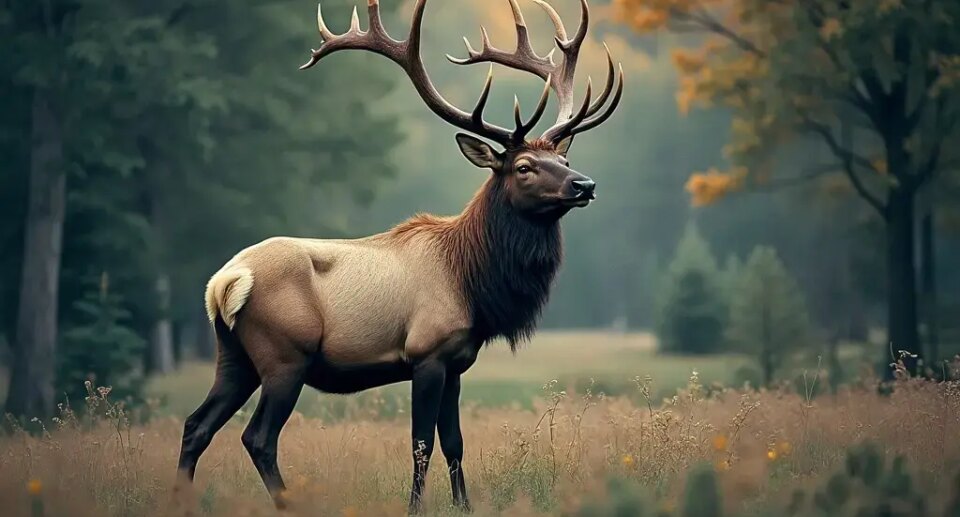Elk spiritual meaning

The majestic elk carries profound spiritual significance across numerous ancient cultures, symbolizing strength, endurance, and the cyclical nature of personal growth. These magnificent creatures, with their impressive antlers and dignified presence, offer powerful spiritual lessons about persistence, leadership, and the delicate balance between independence and community connection.
Key Takeaways
- Elk represent steady transformation through their annual antler regeneration cycle
- They embody a balance between self-reliance and community in their social structure
- Indigenous cultures revere elk as sacred messengers connecting physical and spiritual worlds
- Both bull and cow elk teach complementary spiritual lessons about balanced leadership and nurturing
- Modern spiritual practices use elk symbolism to encourage patient personal growth and authentic power
Ancient Cultural Reverence for Elk
The elk has stood as a powerful spiritual symbol throughout human history, particularly among indigenous North American cultures. The Lakota, Ancestral Puebloans, and many other Native tribes held elk in the highest regard, seeing them as living embodiments of nobility, endurance, and strength. These magnificent creatures weren’t just admired for their physical attributes but were considered sacred bridges between the material and spiritual realms.
In Norse mythology, elk were closely associated with Freyr, the deity of fertility, prosperity, and abundance. This connection highlights how elk symbolism transcends continents, representing the cycles of nature and the promise of renewal across diverse cultural traditions. The consistent reverence for elk across disparate civilizations speaks to their universal spiritual significance.
Archaeological evidence reveals elk imagery featured prominently in ancient ceremonial artifacts and artwork. Petroglyphs depicting elk have been discovered throughout North America, while elk-bone flutes and other ritual items demonstrate their importance in sacred ceremonies. These artifacts weren’t merely decorative but served as conduits for spiritual communication and transformation.
Perhaps most striking is how many cultures independently recognized the elk’s annual cycle of shedding and regrowing antlers as a profound symbol of rebirth and regeneration. This natural process served as a living metaphor for personal transformation, teaching that periods of loss are simply preludes to new growth and greater strength.
Spiritual Lessons of Strength and Perseverance
The elk embodies a philosophy of gradual progress that counters our modern obsession with instant results. Unlike predators who rely on bursts of speed, elk demonstrate the power of steady, methodical advancement. This spiritual teaching reminds us that meaningful growth rarely happens overnight but through consistent effort and patience.
I’ve observed how elk symbolism offers particular wisdom about facing life’s challenges with dignity. Rather than evading difficulties or seeking shortcuts, elk energy encourages direct engagement with obstacles. Their impressive size and strength aren’t used recklessly but applied with purpose and determination when necessary.
The social dynamics of elk herds reveal an ideal balance between independence and community. While maintaining their individual autonomy, elk understand the survival advantage of group connection. This balance offers spiritual guidance for those struggling to honor their personal needs while remaining connected to their communities.
Most remarkably, bull elk demonstrate leadership through protection rather than dominance. They guide their herds with a quiet, dignified presence that commands respect without resorting to unnecessary aggression. This model of leadership—proud yet humble—offers profound lessons for anyone in positions of authority or influence.
Elk as Guides for Personal Transformation
The annual cycle of elk antler regeneration serves as a perfect metaphor for personal growth. Just as elk must shed their magnificent antlers to allow for new growth, we too must release outdated beliefs, habits, and identities that no longer serve our highest good. This natural process teaches us that loss often precedes our most significant periods of renewal and expansion.
Elk symbolism offers particular wisdom about balancing competitive and collaborative energies. Bull elk engage in competitive displays during mating season yet maintain peaceful coexistence throughout most of the year. This duality challenges those who identify with elk energy to examine when competition serves their growth and when collaboration becomes the wiser path.
For those of an introverted nature, elk spirit energy provides a model for expressing authentic power without compromising one’s natural temperament. Unlike more flamboyant animal totems, elk demonstrate that true strength doesn’t require constant external validation or dramatic displays—it can manifest as a quiet, assured presence that commands respect through actions rather than words.
Elk also offer guidance about sustainable energy management. These majestic creatures maintain impressive strength and stamina through balanced activity and carefully selected nutrition. Their example suggests harmonizing periods of exertion with adequate rest and prioritizing quality nourishment—including plant-based sources—to maintain optimal vitality for life’s journey.
Modern Applications of Elk Symbolism
The spiritual significance of elk has found contemporary expression through conservation efforts like those of the Rocky Mountain Elk Foundation. These initiatives reflect a growing recognition that protecting elk habitats preserves not just the physical animals but also the spiritual wisdom they embody. The conservation movement thus becomes a modern expression of the ancient reverence for elk energy.
Several U.S. states have formally recognized the elk’s importance by designating it as an official state animal. Utah claims the elk as its state animal, while Michigan features it prominently among state symbols. These official designations demonstrate how elk significance has transcended purely spiritual contexts to become part of regional cultural identity.
Wildlife documentaries regularly showcase elk behavior, inadvertently highlighting the spiritual lessons these creatures embody. These productions capture the elk’s dignified presence and ecological role, introducing millions to their profound symbolism even without explicitly spiritual framing. Through these media representations, elk wisdom reaches audiences who might never encounter traditional spiritual teachings.
For those actively working with elk as a spiritual totem, practical guidance includes:
- Pacing yourself through challenging situations rather than exhausting your resources
- Seeking companions who value both independence and mutual support
- Prioritizing balanced nutrition as a foundation for sustainable energy
- Practicing patience with personal growth processes, recognizing that meaningful change takes time
Spiritual Dynamics of Bull and Cow Elk
Bull elk represent the masculine spiritual principles of protection, outward strength, and visible leadership. Their impressive antlers and commanding presence symbolize the power of decisive action and the courage to stand as guardians. This energy connects to our capacity for initiative, boundary-setting, and principled confrontation when necessary.
In complementary fashion, cow elk embody feminine wisdom through their intuitive guidance, nurturing energy, and emotional intelligence. Their focus on herd cohesion and offspring protection represents the spiritual qualities of compassion, foresight, and community sustainability. The cow elk’s energy resonates with our capacity for empathy and long-term planning.
Together, bull and cow elk illustrate the balanced forces essential for spiritual wholeness. Rather than viewing these energies as strictly gender-based, I recognize them as complementary aspects available to all beings regardless of gender identity. The external courage of bull elk energy works in harmony with the internal wisdom of cow elk spirit to create a complete spiritual toolkit for navigating life’s challenges.
This balanced perspective teaches that authentic spiritual power doesn’t require choosing between strength and sensitivity—it emerges from integrating both qualities. The elk’s example suggests that our most effective responses to life’s challenges flow from honoring both our protective instincts and our nurturing capacities, adapting our approach based on the situation rather than limiting ourselves to a single mode of engagement.
This article explores the spiritual significance of elk across different cultures. Elk symbolize strength, endurance, and transformation through their annual antler regeneration. They’re revered in indigenous North American cultures and Norse mythology as sacred beings connecting physical and spiritual worlds. The elk’s balanced lifestyle demonstrates how to maintain independence while valuing community connection. Both bull and cow elk offer complementary spiritual lessons about leadership, protection, and nurturing. Their symbolism continues to influence modern conservation efforts and regional identities.
| Key Aspect | Spiritual Significance |
|---|---|
| Antler Regeneration | Symbolizes cycles of personal growth and transformation |
| Social Structure | Demonstrates balance between self-reliance and community |
| Cultural Status | Considered sacred messengers in indigenous traditions |
| Leadership Model | Teaches protection over dominance and patient progress |
| Modern Relevance | Inspires conservation efforts and spiritual practices |














